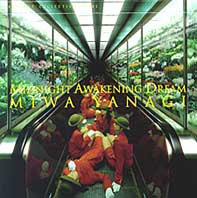YANAGI Miwa
YANAGI Miwa やなぎ みわ (1967- ) Kobe, Hyogo. Kyoto-based woman photographer who embraced digital imaging early on.
Education Graduated Kyoto City University of Arts' graduate program in art.
Career Started using the Macintosh for image editing early on. Gained attention with her elevator girls series in 1993.
Recent work is titled "My Grandmothers" featuring young women who try to envision what they would look like 50 years later.
Awards 1998 Leopold Godowsky Jr. Color Photography Award, Photographic Resource Center at Boston University 1999 VOCA Prize, VOCA '99 (The Vision Of Contemporary Art '99)
Web site: http://www.yanagimiwa.net/e/index.html
Midnight Awakening Dream
 Reviewed on: 2002-02-27
Last modified: 2005-04-03
Reviewed on: 2002-02-27
Last modified: 2005-04-03
Book of postcards showing her "Elevator Girls" series of surreal, digital images.
エレベーターガールの仕事はやはり無意味。
Published: 2001 Publisher: amus arts press ISBN: -- Price in Japan: ¥1,350 Qualities: Soft cover, color photos Size: Postcards, 28 perforated cards Language: English
The appearance of digital photography and image editing of photographs has led to a big debate between film-based traditionalists and digital believers. The former despise digital editing and manipulation calling it "fake." While the believers, usually younger and techno-savvy, have embraced the technology.
Other people find themselves caught in limbo, wondering how or when to switch over to digital. With every new or different medium, there will be people who find ways to use it for artistic expression. In the digital imaging realm, Miwa Yanagi is one of them. She is one of the very few established Japanese woman artists who incorporate digital imaging.
She first gained significant attention with her "Elevator Girls" series which she started out in 1993. In Japan, elevator girls are those young, attractive women in uniform who operate the elevators in large department stores. They work inside the elevator, pressing the floor buttons for customers while traveling up and down. They also stand outside the elevator to announce when the elevator has arrived. Some people might see it as a glamour job, but it can be hazardous due to gropers or worse.
Unfortunately, this is only a book of 28 regular-size postcards, and not a photo book. The quality of the photos certainly warrant a full-blown photo book. She also has a lot of panoramic-type photos, but the postcards are in the regular size. So the panoramic shots are cut up into three regular-size postcards. This greatly dulls the visual impact of the original work. The publisher should have made it a panoramic format so that the whole picture can fit in.
The elevator girls are shown in various settings. The first group of photos, called "The White Casket," show three elevator girls in red uniforms lying down on the floor of an elevator. They later transform into a glob of red paint on the floor.
The girls are shown either in confined spaces or in a large commercial space such as a department store or shopping mall with no place to go. They look like monotonous drones. This series is no doubt a visual and critical comment on Japan's treatment of women. As visual images, they look really intriguing. You could call it art.
The artist turned to digital image-editing because she could not otherwise create the scenes that she wanted to see. She started with a small Macintosh which took her an hour to save an image. She admits spending enormous amount of time to create just one image. Thanks to faster computers, things are faster now. But still, she can only produce no more than a few digital images in one month.
That's the devil in digital imaging. There's no end in what you can do, so you spend hours until it looks right or perfect. If you don't have the time, stick to film. (Reviewed by Philbert Ono)